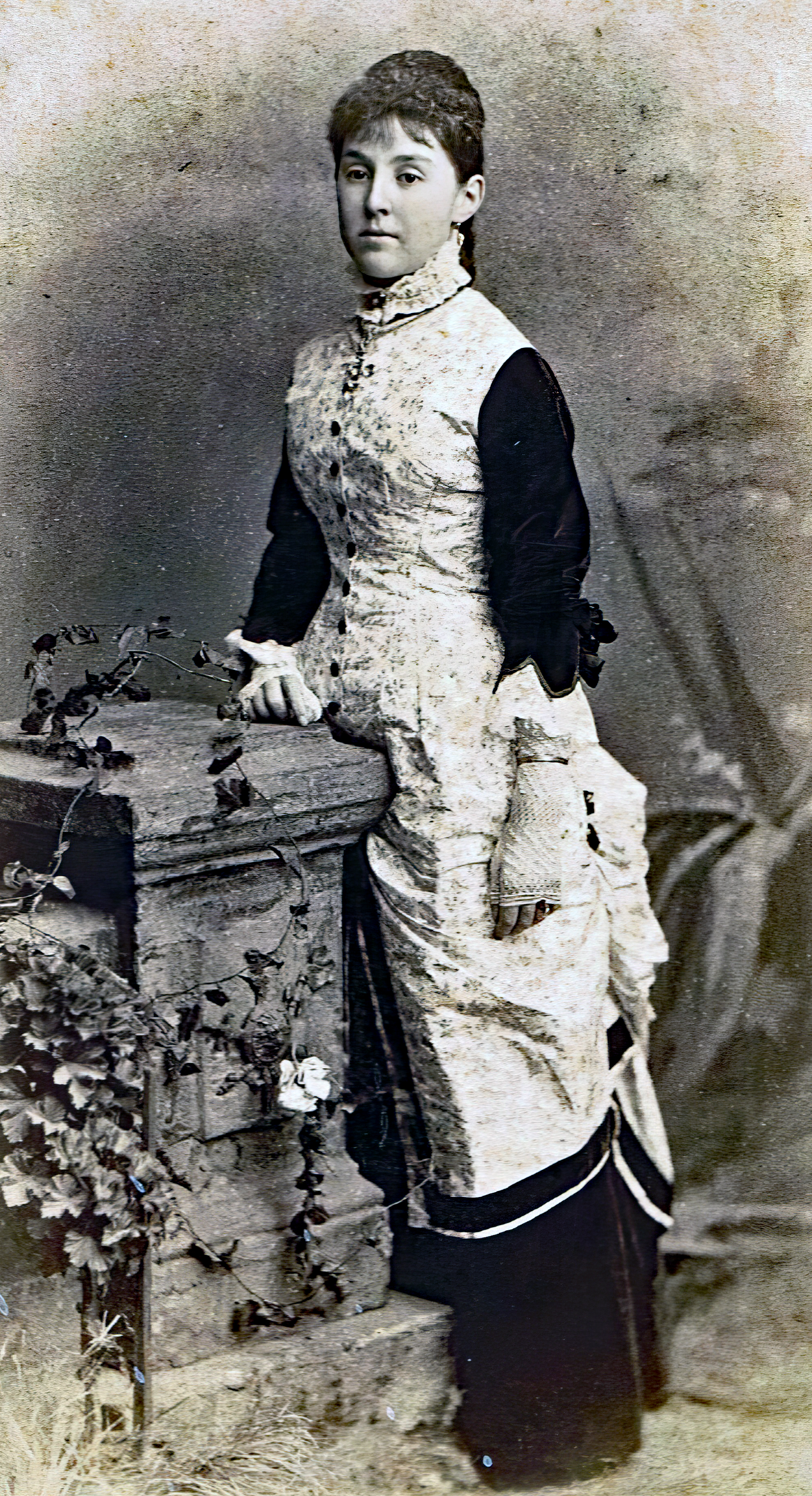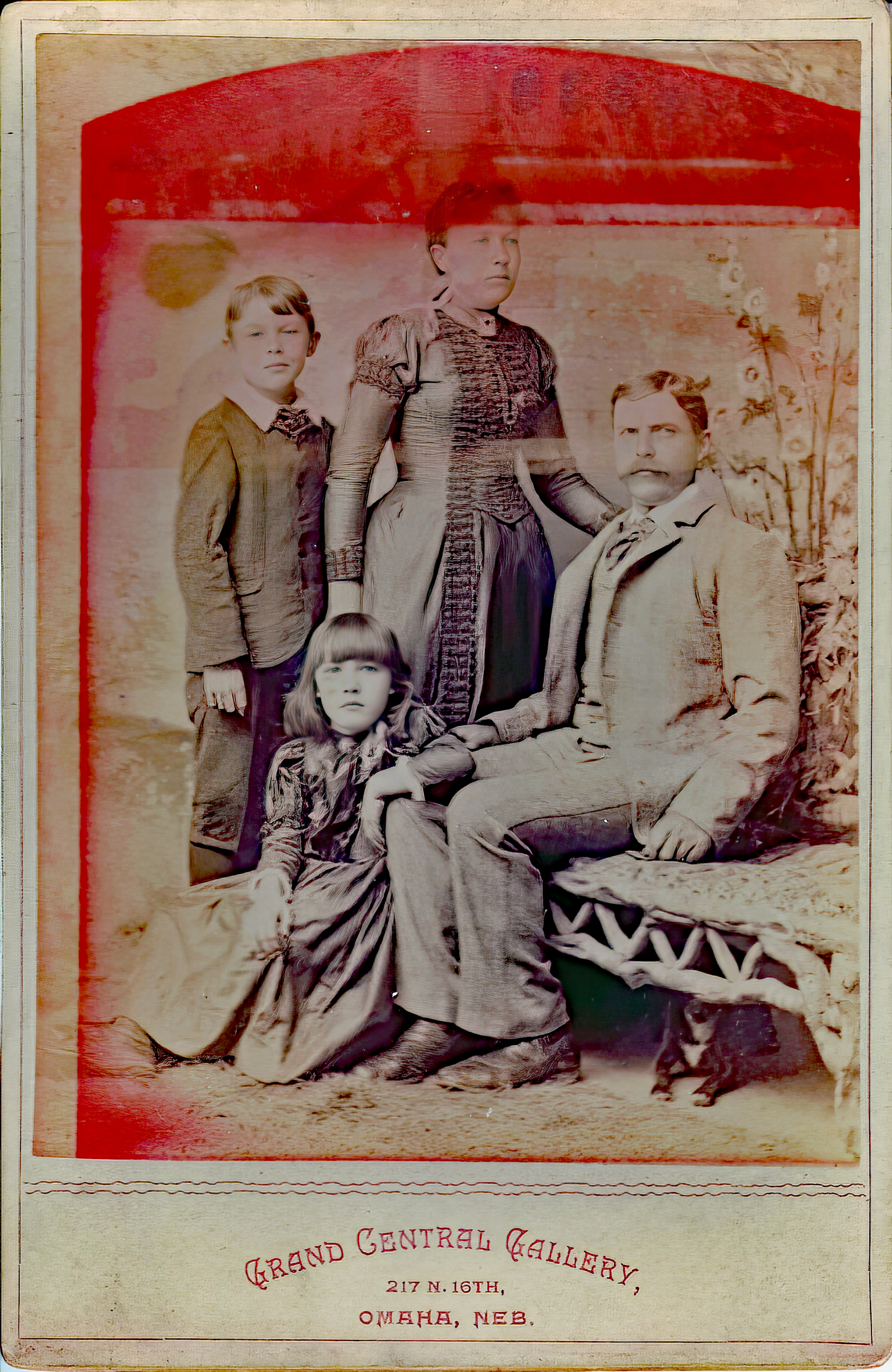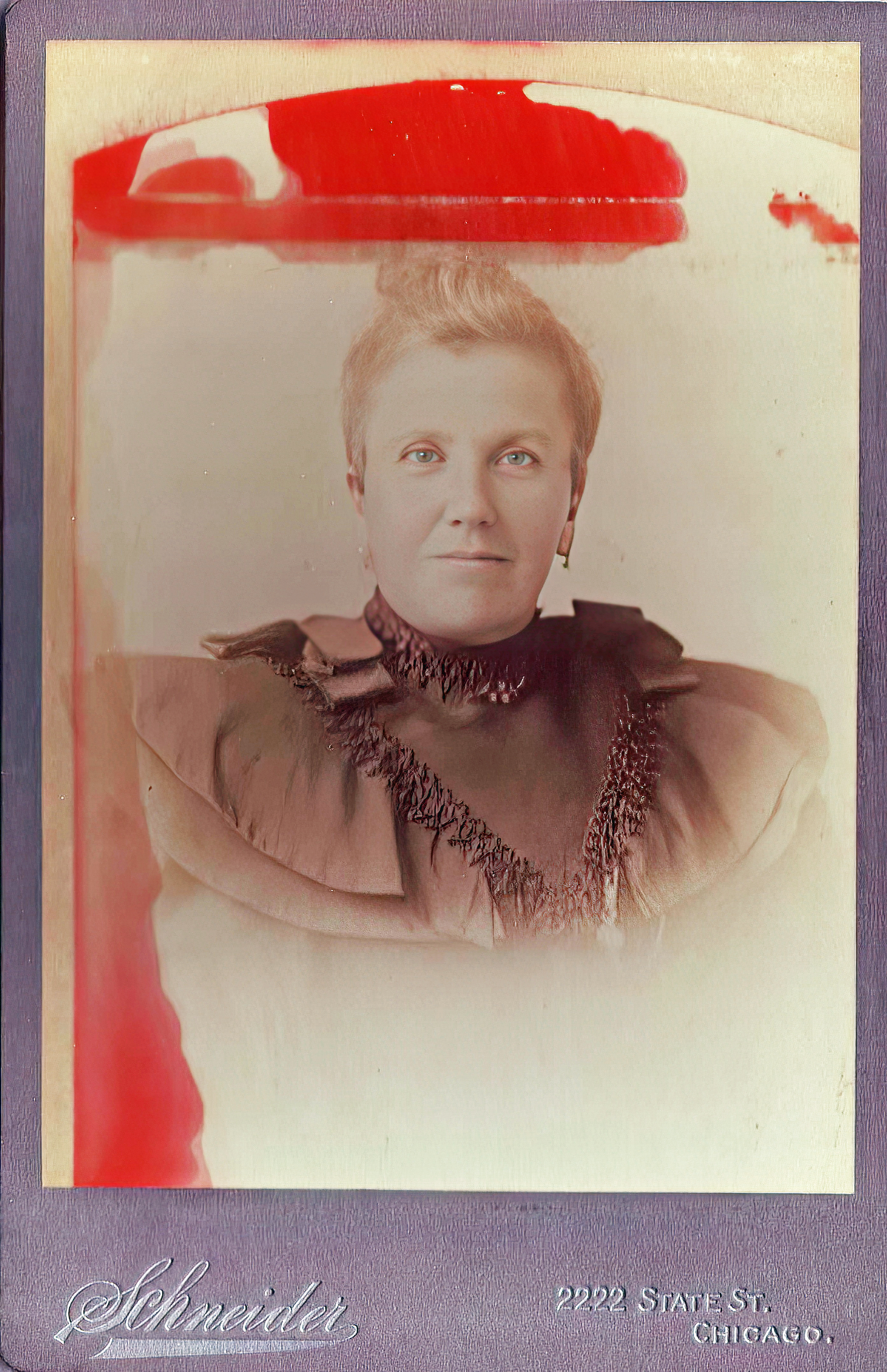Portraits
Sometimes we'd like to know a little more about an individual photo or document, something that can't be detailed in the website blog or dedicated content. That's what Portraits will cover.
“A thing that you see in my pictures is that I was not afraid to fall in love with these people. – Annie Liebowitz
The wedding portrait in the banner above is one such example. On its surface it's a collection of family and friends celebrating the wedding of Anna Petersen and Franz Hinrich Politz around 1935. But it tells a more complex story about family connections and how they're captured and documented for future generations. That's what we'd like to explore in each image. What's the person's background? Where were they when this image was taken? Are there family stories that help us understand their history? Those are the historical gems we want to explore.
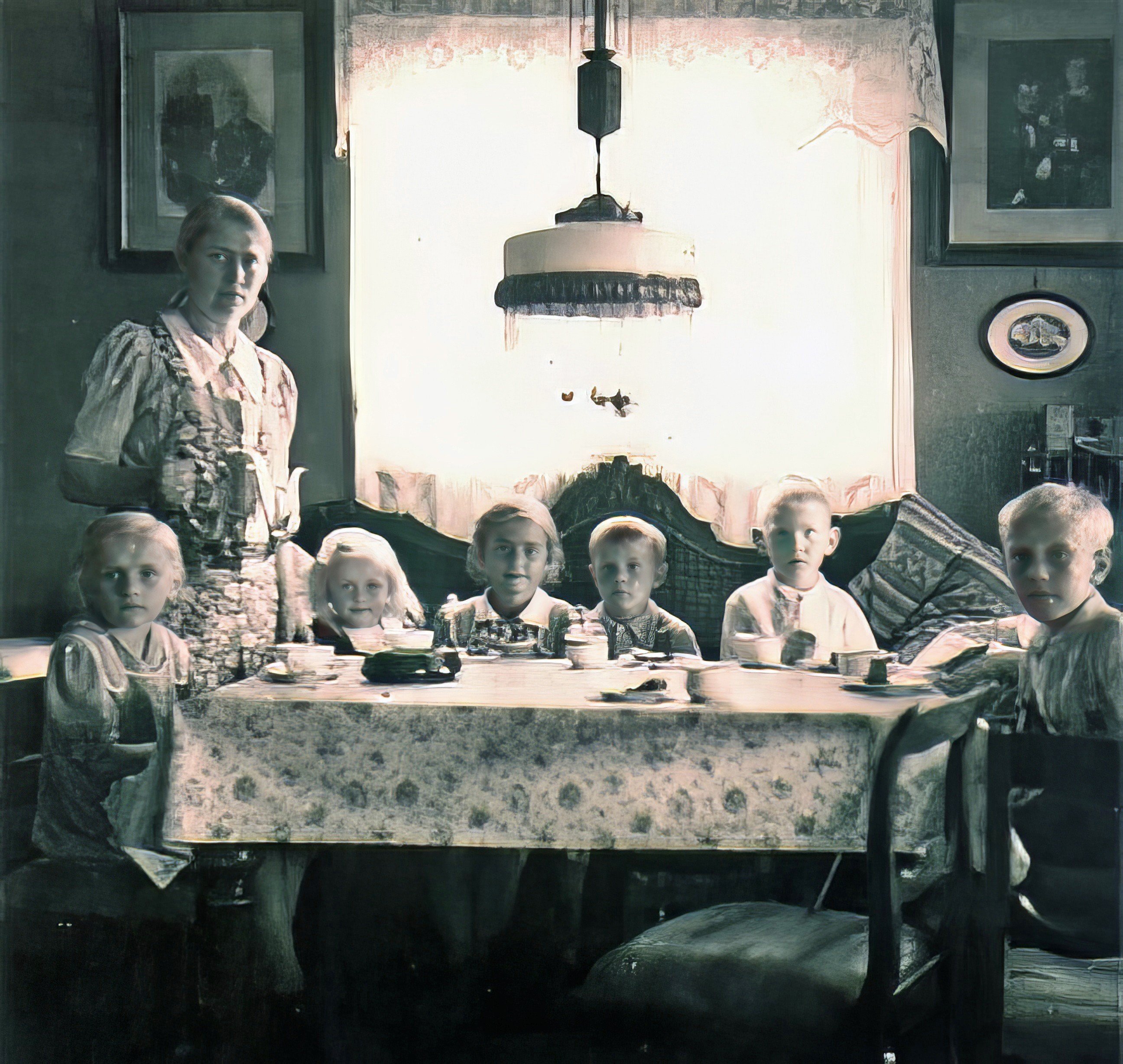
Petersen family, Dithmarschen
We're not exactly sure who the lady is in this portrait, nor can we identify all the children sitting around the table about to have a meal, but there's no question that these are Petersens from our cousin's family in Dithmarschen, at the very northwest section of Schleswig-Holstein. Comparing the lady with other family photos it's likely that she's one of the daughters of Matthias Petersen and his wife Esther Möller Petersen, possibly either Helene Marie (born in 1896) or Botilla (born in 1897). But it's the portraits on the wall that are worth a second glance.
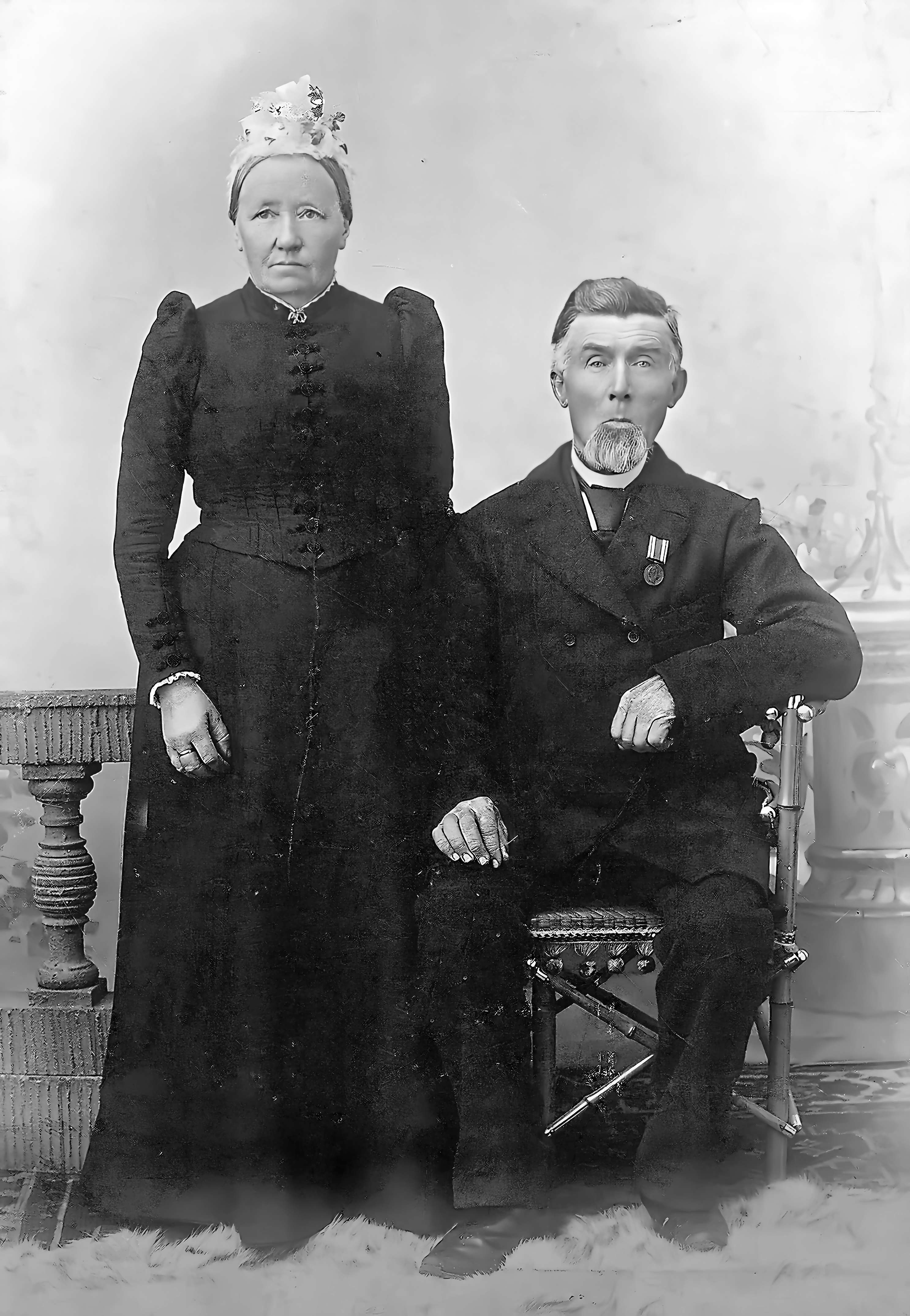
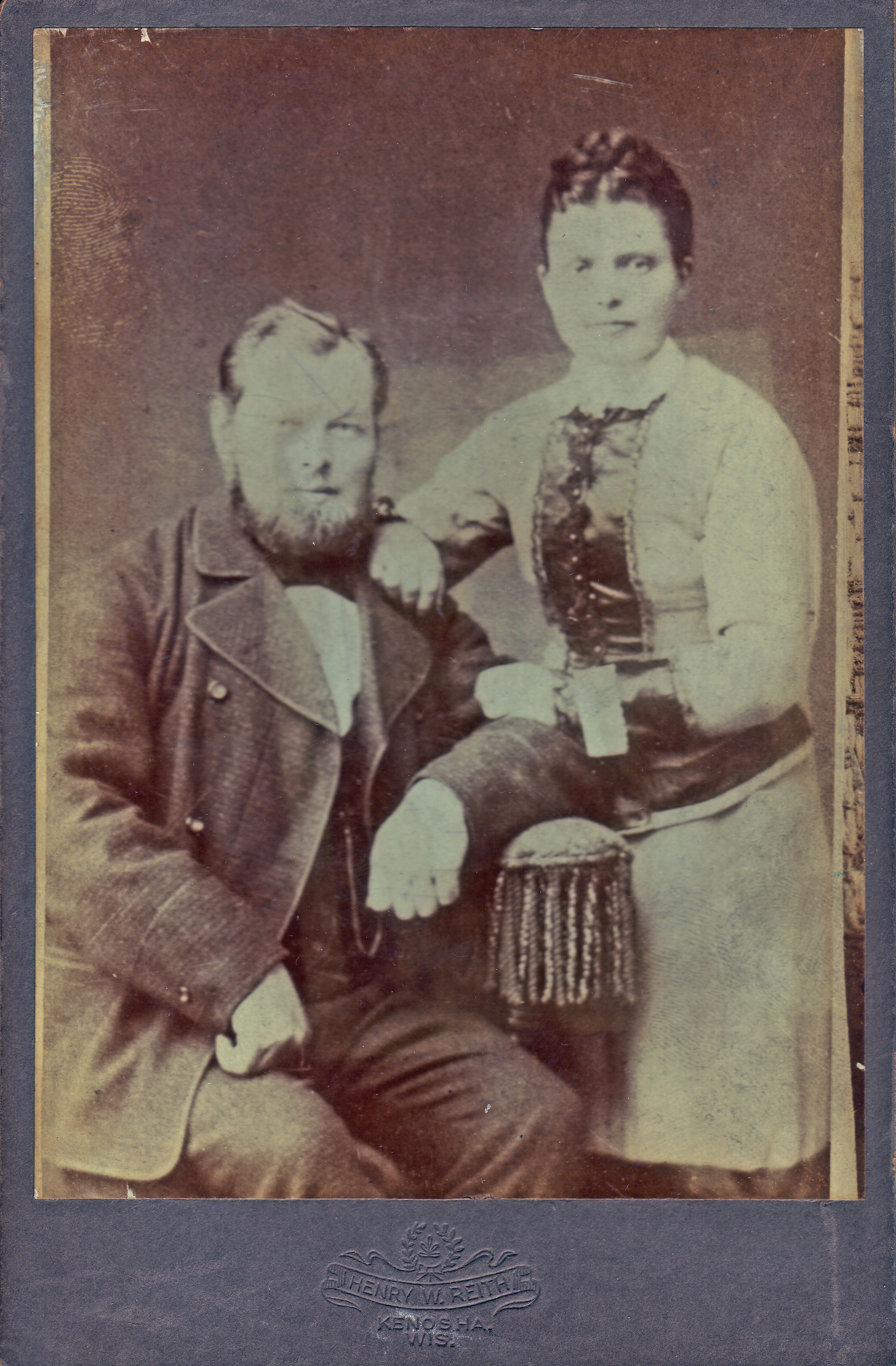
On the left side of the room is a framed photo of Hans Hansen Möller (seated) and his wife Botilla Petersen. On the right side is Fritz Burmeister (seated) with his wife Helena Marie Petersen behind him. Remarkably, we have copies of these two photos too.
The photos are great-grandparents of some or all of the children, and were parents of Matthias Petersen and his wife Esther. If the lady in this picture is one of their daughters, these are her grandparents. Whoever these people are it's clear that they felt it important to honor their ancestors with their dining room display.
Our copy of the Fritz/Helena photo came to us via a faded cabinet card copied in Kenosha, Wisconsin and kept in the collection of Catherine Petersen Mikkelsen of Chicago, who was Helena's sister. Another family member had an identical photo in Omaha, Nebraska. So the Petersens of the new world treasured this keepsake of their sister and her husband.
Our Petersen relatives in Schleswig provided the photo of Hans and Botilla, and we're grateful for it. Photo collections help us visualize and remember our ancestors in a way that documents cannot. How fortunate we are! It's not every day that families can share portraits across the years.
Photo collection: Mario Petersen
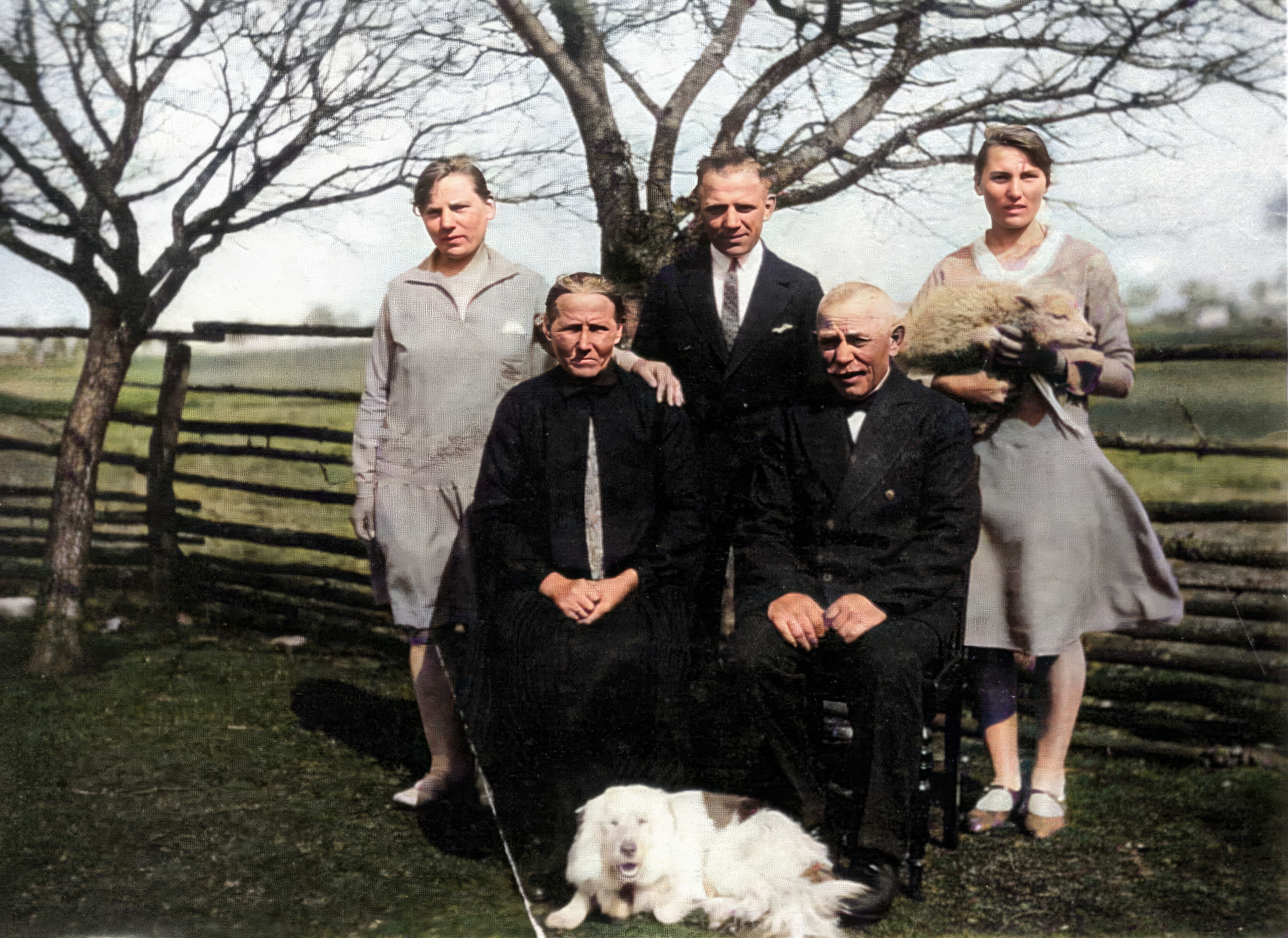
Auguste Marzusch Neumann and family, Schwartz Damerkow
Auguste Marzusch was born in June 1876 in Schwartz Damerkow, a village in Kreis Stolp, once part of Pomerania but now in Poland. She's pictured here with her family: husband Karl Neumann and children, standing; Emma Neumann, Ernst Neumann, Anna Neumann. Anna hold a little lamb and the family dog (of course) is included in the portrait.
What's interesting to us is the fact that we have a DNA match with Auguste and her mother, Alwine Gohr, born about 1832 to the farmer Martin Gohr and his wife Karoline Steinhardt. Alwine was born in the Dambee district of Stolp, a residential area of Wottnogge, although she died in 1920 in Schwartz Damerkow. She was an elderly widow, her husband, the late controller or steward ("Hofmeister") Albert Marzusch, having predeceased her.
The DNA match to one of her descendants is worth exploring. The Gohr line seems the likeliest connection to his family and it's important because it's the only macth we have to a Gohr not already known to be a part of our Gohr ancestry from nearby Nippoglense.
Martin Gohr likely had some connection to our Gohr families in the region. If we can find out more about him and his ancestors it could lead to an understanding of our mystery Gohr, Wilhelm Heinrich Gohr, also a farmer, for whom essential documentation is missing. We have no baptism, marriage, or death records for Wilhelm, just records of his twelve children with his wife Emilie Louise Lübeck in the towns of Nakel and Nippoglense from 1838 to 1857.
Our best estimate is that Wilhelm was born about 1805-1810. That's not too far off the birth estimate for Martin Gohr, whose daughter Alwine was born in 1832. Martin would have been about twenty-five to thirty years old when she was born, assuming she was his first child. Martin's estimated birth year and Wilhelm's were thus pretty close. Were they brothers? Cousins? We don't yet know but further research may reveal something ... and could clear up the family mystery.
Photo collection: C. Neumann
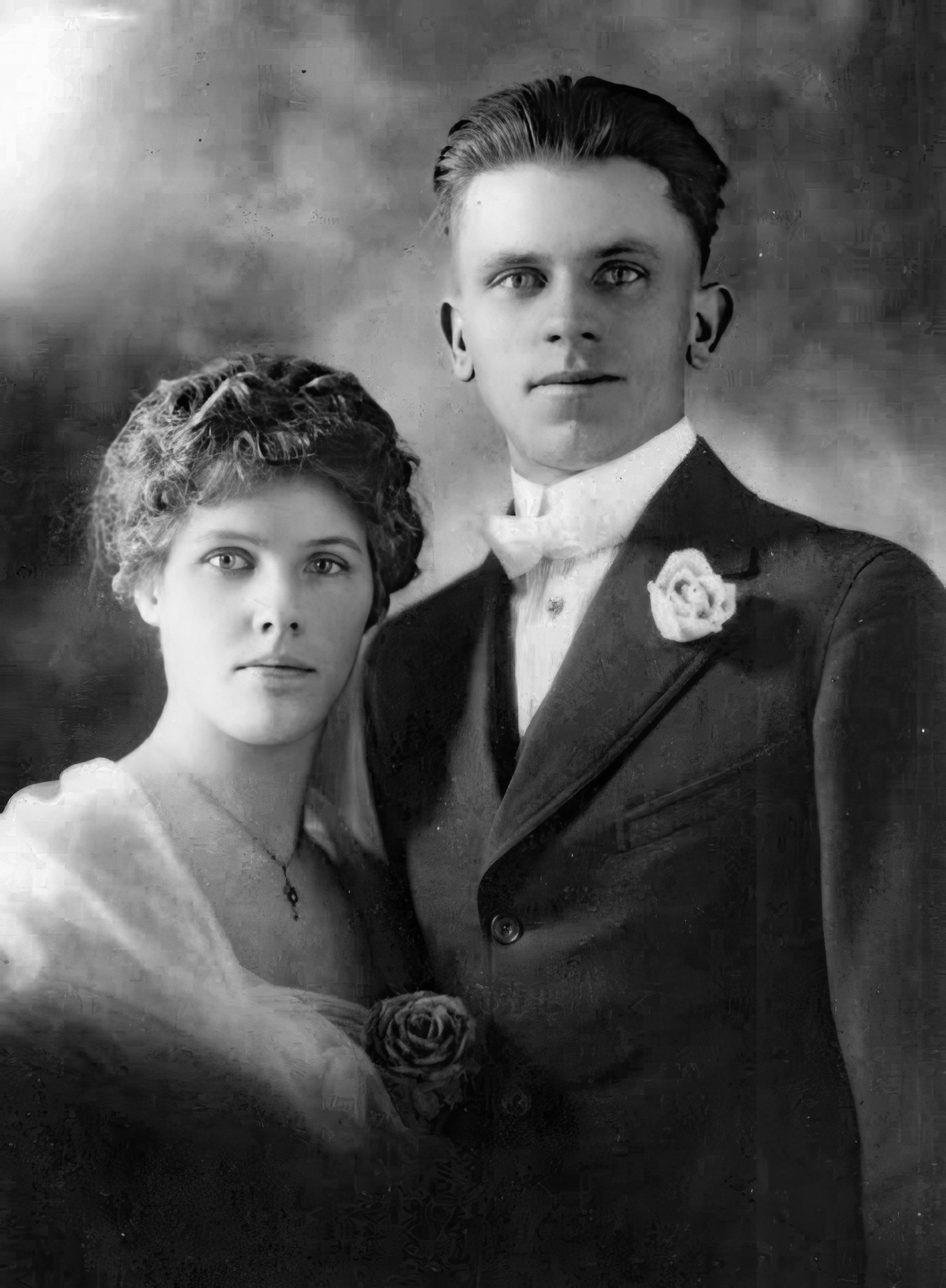
Edith Oleta Kebschull and Harry Peterson, 1920, Bridger, Montana
Edith Oleta Kebschull was born in 1901 on her parents' homestead ranch in Bridger, Montana. She was the youngest of five children born to Otto Kebschull and Ida Scheunemann Kebschull, who emigrated to Montana about 1890. Otto's brother, Reinhold Traugott Kebschull, remained in Groß Nossin but several of Reinhold's grown children followed Otto and his family in 1923. This Kebschull clan is related to our family via the Lübecks of Klein Nossin.
Active in social activities in Bridger, Edith met Harry Peterson (no relation to our other Petersen families, from what we know) and they married at the bride's parents' home at 11:00am on October 27, 1920.
According to a local news item in the Bridger Times, the wedding was followed by a "sumptuous wedding dinner" for seventy-five invited guests. Harry had his own ranch in nearby Golden where the couple "commenced housekeeping at once."
This photo displayes the happy couple after their engagement. Edith, her hair arranged in the then-popular Marcel waves of fashionability, wore a simple gown with a red rose pinned to her bodice while Harry sported a wite rose as a boutonniere.
The couple had seven children. They eventually took over her father's ranch but then purchased their own 208-acre property where they farmed alfalfa, wheat, oats, barley, and beans (Harry's favorite crop), as well as raising sheep, cattle, and chickens. Harry's favorite pastime when not farming was fishing, while Edith loved gardening and raising flowers.
Edith died in 1985 and Harry in 1987 after a long and happy marriage.
Photo collection: Dixie Armstrong
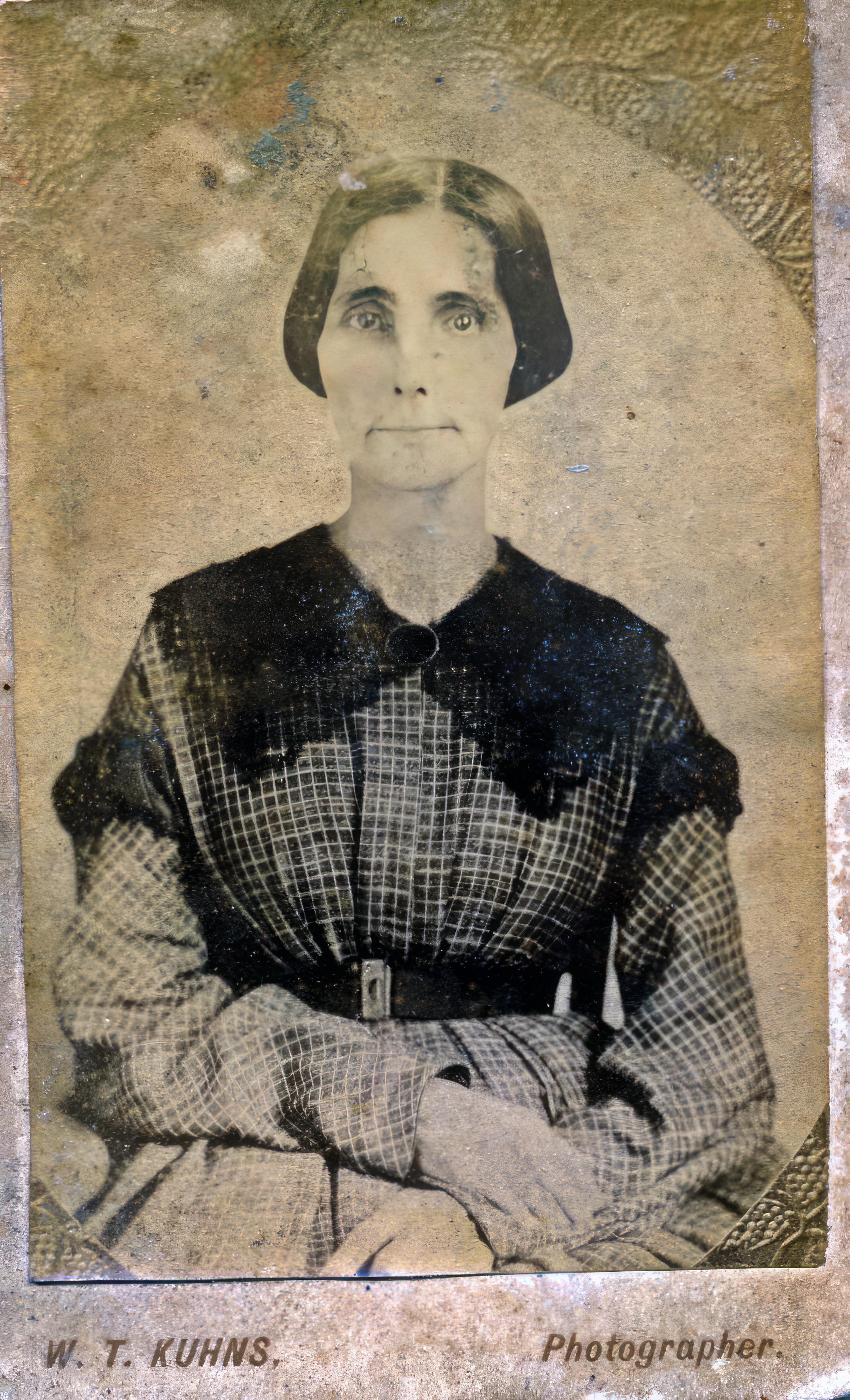
Rebecca Scott Wier, Atlanta, Georgia about 1860
The online database Find-A-Grave yields some arresting images and this is one of them: Rebecca Scott Wier was the wife of Swansea (also Swancy or Swanzy) Wier. Rebecca was born in Laurens County, South Carolina about 1812 and lived in Abbeville where she was married to Swansea in 1834. Rebecca is related to our family by marriage. Her grandson Russell Blake Speights married Helene Jennie Marie Müller, daughter of Carl Müller and Mary Amme in Charleston.
Online trees are often problematic. Some Wier descendants insist that their line is represented in the English Domesday Book of the eleventh century and that there's Scottish and Norman nobility buried in the mix. It could be, but reliable documentation doesn't exist to help anyone trace this theory so it's unproven for now.
Rebecca was born in Laurens County, South Carolina and married Swansea in nearby Abbeville in 1834. Their growing family is documented in census records for Pike County, Georgia and Randolph County, Alabama, with a return to Laurens in 1880. While in Georgia the family had this circa 1860 photograph duplicated at the W.T. Kuhns photography studio in Atlanta.
Rebecca's probably homemade checked dress, with its simple pleats and cinched belted waist, is typical for the day-dress fashion in the early 1860s, and the hairstyle, combed over the ears and wrapped in a bun at the back of the neck, was most popular in 1860, whereas waves and curls began to be seen later in the decade. Black lace, an atypical decorative embellishment (popular lace accoutrements were more often white) decorates the collar and upper sleeve, while a black brooch holds the lace collar in place.
Because this outfit and hairstyle are typical for 1860 and we know that the W.T. Kuhns studio was not established in Atlanta until 1870 (previously he was set up in Tallahassee, Florida), it's likely that an original portrait probably existed at one time and was copied at the Kuhn studio sometime after 1870. The Wier family was enumerated in Wedowee, Randolph County, Alabama in the 1870 census so perhaps one of the family who still had business in Atlanta had this simple, square-edged card made up at that time. Note the perfunctory studio stamp: this was not one of the higher-end cabinet cards with embossed identification marks.
Anyone wanting to consult the Find-A-Grave entry may do so here, where there's more information about the Wier family.
Photo collection: Ray Isball
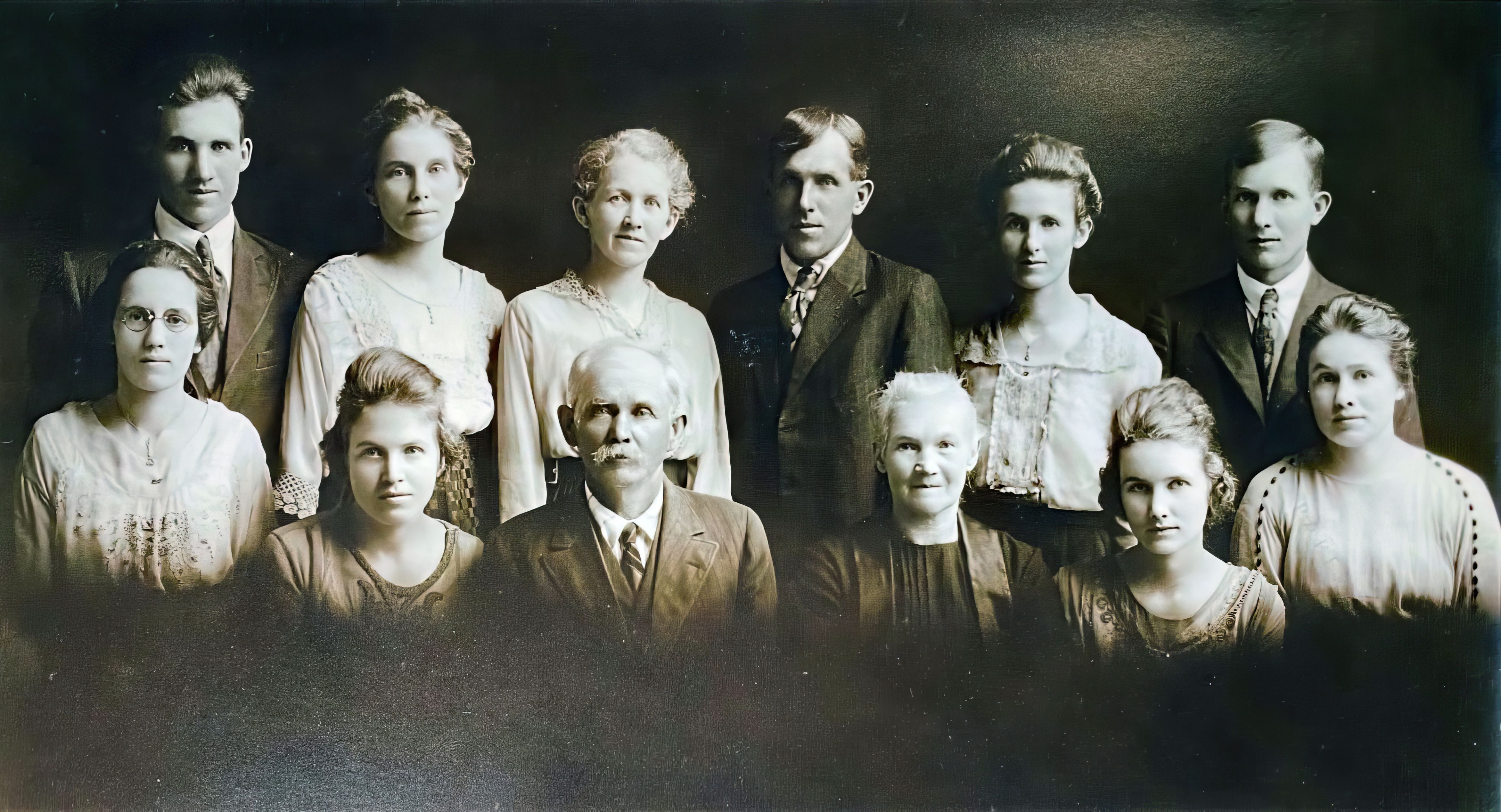
Albert and Wilhelmine Gohr family, Kimball, Minnesota, 1922
Sometimes documents don't tell the whole story. In the case of this family we rely on DNA testing to tell us that we're related. We just don't know how.
It's a stunning portrait. Albert Wilhelm Gohr and his wife, Wilhelmine Stenke, and their grown children assembled for a group photo in Kimball Township, Minnesota in 1922. Albert and Wilhelmine were both immigrants from what is now Poland, then Pomerania. Albert was from the town of Zetzenow and Wilhelmine from Lessiko but they met up in Chicago and were married there in 1876.
Bottom row: Olga Emma, Esther Carolina Wilhelmina, Albert Senior, Wilhelmina, Clara, Hedwig (Hattie) Wilhelmina; top row: Leo, Wilhelmina, Adeline (Lena), Albert Junior, Dora, George Albert.
We know that Albert is linked to Gohr families from Nippoglense, Kreis Stolp and possibly from other parishes but available records don't exist that might give us a clue about the exact connection. Albert seems to have been the relative who ended up in Minnesota while the other Gohrs remained in Chicago.
Someday some cache of records may reveal how we're connected.
Photo collection: Laurie Hendrickson
Elise Jatho, Charleston, c. 1881
Elise was the younger daughter of jeweler and watchmaker Georg Wilhelm Jatho and his wife Elise neé Schuckmann, born at the height of the Civil War (or as some refer to it, the "war of Northern aggression" or "the late unpleasantness"). Elise Clara Margaretha was named after her mother but we don't know where the other two names came from because G.W. Jatho apparently eschewed formal religious observance and did not have his children baptized during their birth year. A contemporary entry might reveal Elise's godparents.
After G.W. died in 1970 the entire family of children appeared one Sunday in 1873 at St. Matthew's German Evangelical Church on King Street and were baptized en masse from twenty-one year old Philip down to seven year old Carl Julius. You can see the record here.
Elise lived on Wentworth Avenue with her mother and siblings after her father's death. Her mother taught German by way of making a living. Her older brother Philip was a clerk in the U.S. District Court in Charleston. This rather melancholy portrait captured the younger Elise at just twenty years old, dressed in what was then the height of fashion. a flowered over-apron covering a velvet gown with lacey fingerless gloves.
You can click the image to enlarge it, and you may see a hint of a ring on Elise's left hand. Was this an engagement portrait? If so, we have no knowledge of who her fiancé may have been because Elise died of typhoid fever (then untreatable) shortly after this photo was taken. Her funeral was held at St. John's Lutheran Church and she was buried in the Jatho plot at Magnolia Cemetery just north of town. It was a sad end to a promising life.
Photo collection: Louis Quin
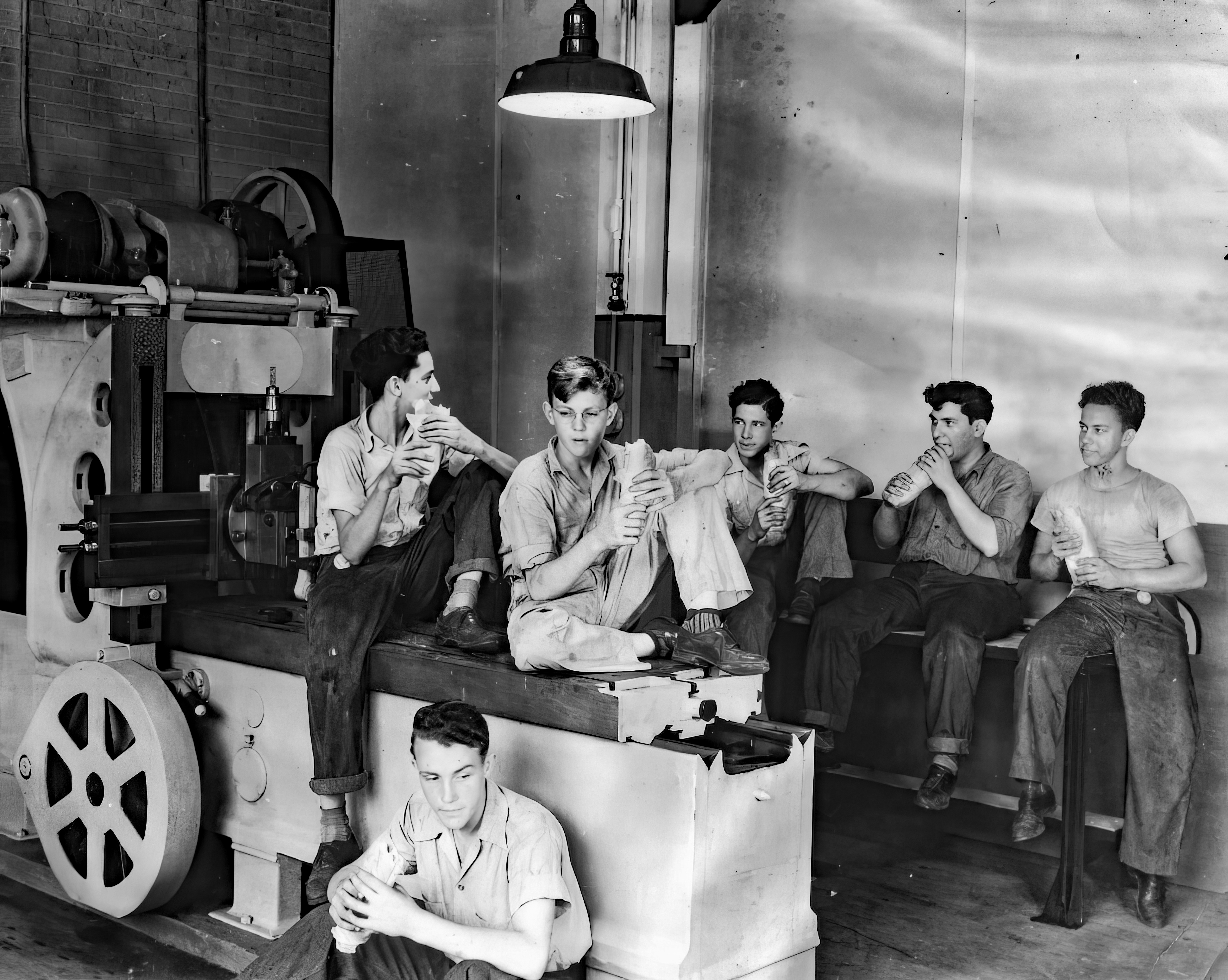
Edgar W. Jatho and friends, New Orleans, c. 1942
Edgar Jatho (center) and his workmates were probably in the shop in the summer of 1941 or 1942 where a drill press of some sort was elemental to their job. But there was always time for lunch, po'boy sandwiches from the look of it, a New Orleans speciality.
Edgar was the son of Norwood Jatho, born in Charleston, South Carolina but relocated to New Orleans, and Adelaide Gadpaille, a New Orleans native with ancestral roots in Jamaica. Norwood worked as a salesman in a printing establishment
Edgar worked at A-1 Plumbing & Heating as an adult, and he married Ethyl Barthe in 1947. The youngest of Norwood's four sons, he and Ethyl had two sons of their own, Edgar and Norwood, plus a daughter Barbara.
Until recently the New Orleans Jatho family didn't realize that they had South Carolina roots. Their patriarch, Edmond Dantes Jatho, was born in Charleston in 1860 and spent a few years in New Orleans until the burden of personal debts became unmanageable. He returned to Charleston to study law while his wife Edith Ripley and four children eventually assumed that Edmond had died.
Quite the contrary! Edmond made his way to Chicago, working as a procurement agent for the U.S. Army, and he died there in 1910. He was a legend to his descendants in New Orleans who believed he'd come from Germany and left his castle and fortune behind in the old country. Alas, no, Edmond was born in the USA and the Jathos never owned castles in Germany. In fact, Edmond's father, jeweler and watchmaker G.W. Jatho, left Kassel in 1848 at a time of political upheaval in Germany and it's doubtful that he brought much money with him when he settled in Charleston.
We have no photos of Edmond but it's possible that his grandson Edgar looked a lot like him.
Photo collection: Edgar W. Jatho
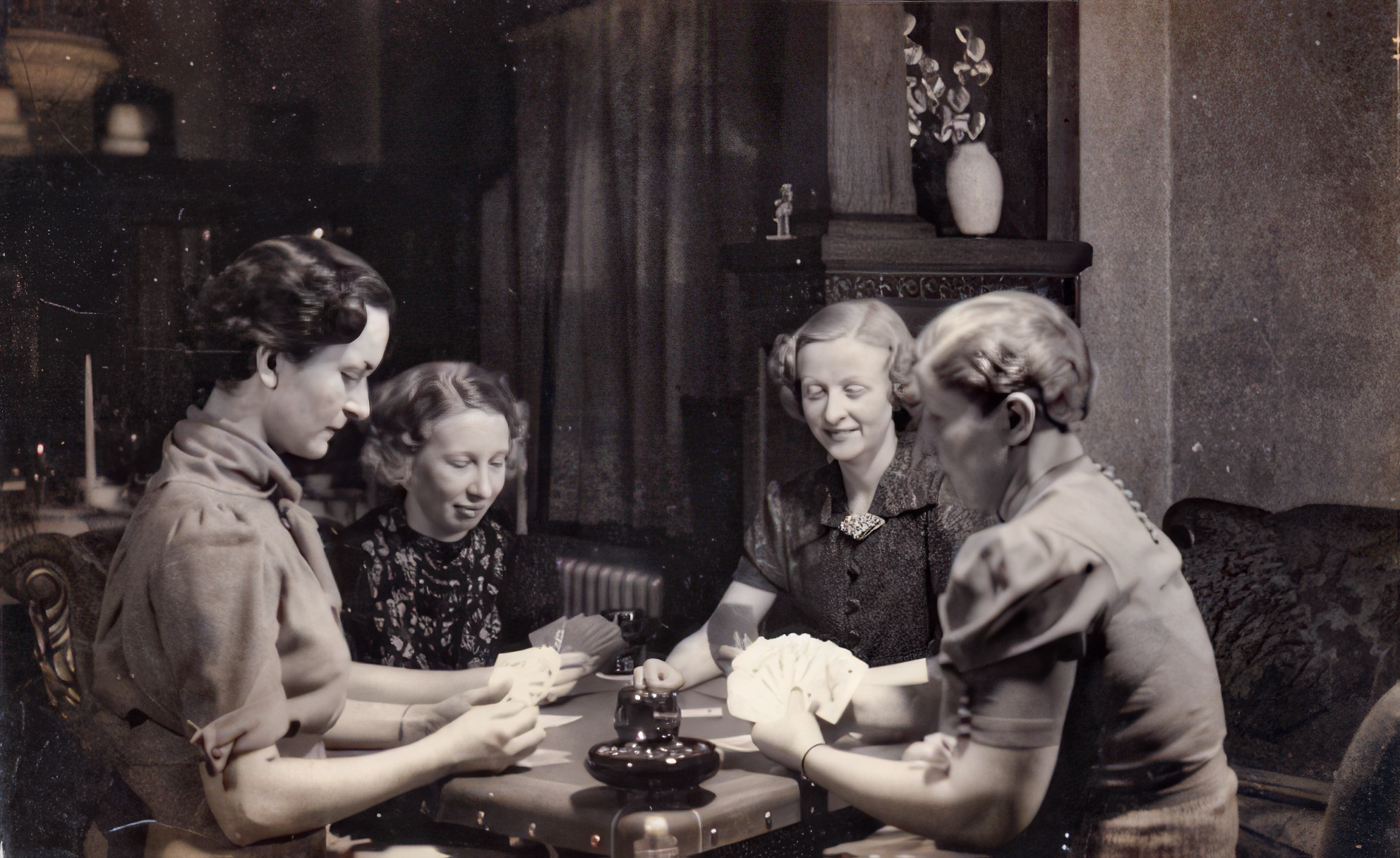
Friends and cousins playing cards, c. 1940
It almost looks like a painting or a carefully lit movie scene.
This probably took place in the home of John and Anna Glawe around 1939-1940. Two cousins and their friends were photographed by someone who caught them focusing on their card game in the front parlor. If you look carefully in the background you can see some of the domestic decor: vases, flowers, bowls. Looks like a cozy setting for these young women.
From Left: Edythe Marie Rathje, daughter of Fred C. Rathje and Elfrieda neé Naumann, was a friend who lived in the neighborhood on Sangamon Street, and who would marry one Truman M. Smith a year or so later, so we know from the inscription on the back of the photo that she was still single.
Next to her was Dorothea Misch, a 1932 graduate of Calumet High School where her friend Dorothy Glawe also attended. Dorothea was a member of the Calumet Honor Society as well as a participant in the high school Latin Club and Golf Club, an athletic lass involved in volleyball and tap dancing, and apparently fond of cards as well.
Lit by some ethereal light next to Dorothea is Loretta Murphy, daughter of Owen Murphy and Emma Hasse, and a cousin of Dorothy Glawe who is seated at right. Loretta was the granddaughter of Augusta Kramp Hasse, who with her sister Laura Kramp came to Chicago in 1881 where Laura would marry her fiance Wilhelm Gohr, whose emigration preceded hers. Loretta is probably named for the late Laura Kramp Gohr who died in 1893 after the brith of her eighth child. Loretta went on to marry Joseph Mayhan around 1940.
Dorothy Glawe at right was the middle daughter of John Walter Glawe and Anna Gohr (eldest daughter of Wilhelm Gohr), so Loretta was her first cousin. Dorothy, born in 1913, had graduated from high school and by this time worked as a comptometer operator in a telephone company in Chicago. A comptometer was the first commercially successful key-driven mechanical calculator, and its operators were highly skilled.
It would have been nice to relax in the evening and spend time with friends and relations.
Photo collection: Anna Gohr Glawe
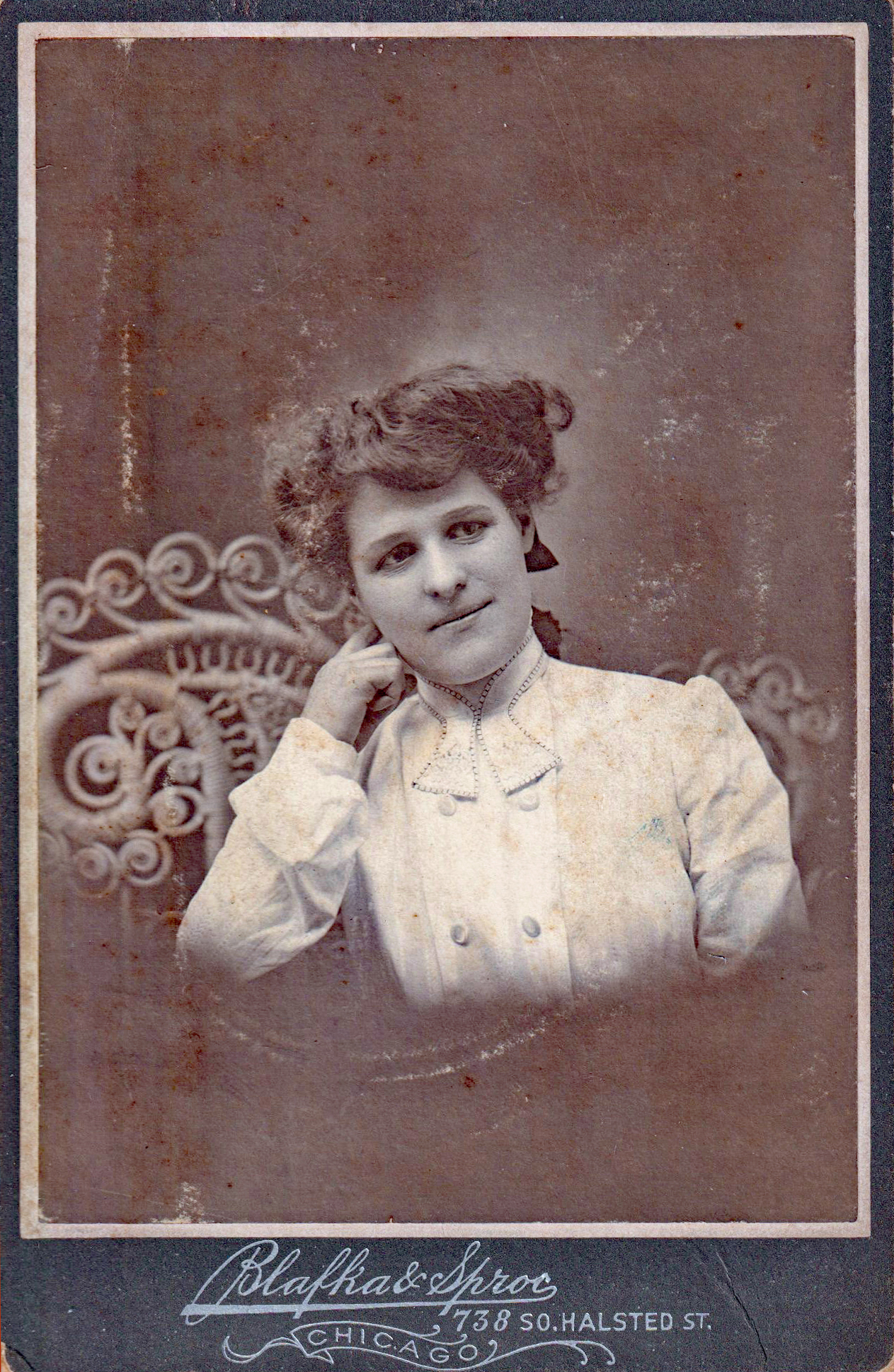
Anna Gohr, c. 1900
It was customary to arrange for photo sessions just prior to or after a young lady's engagement, and that may well be what's documented here. Anna Gohr, born in Chicago in 1882, was the eldest daughter of Wilhelm Gohr and Laura Kramp Gohr. She had a twin sister, Wilhelmina (Minne) but due to Minnie's deafness and residence at the Elgin North Illinois Hospital where Minnie spent much of her time, Anna was usually not photographed with her twin sister until much later.
The studio, Blafka & Sproc, was located on Halsted Street in Chicago, a popular area for local photographers. Anna wears a delicate blouse with a jeweled collar and has her long hair arranged in the back of her head secured with a dark ribbon. Other than the collar, no jewelry is visible.
Anna's father Wilhelm, a laborer, was still alive at the time of this portrait but her mother Laura Kramp Gohr had died in 1893 of what was likely puerperal fever, an infection common at a time when simple childbirth was fraught with peril (the baby, called Elsa, died eight days before Laura). Anna and her six siblings were left in the care of their father and whatever local relatives could help out with their upbringing.
Anna's fiancé was John Walter Glawe, born in Wisconsin to German immigrant parents, a carpenter. He and Anna were married in 1906 in Chicago and had three daughters, who were also well represented by frequent visits to their local portrait studio.
Photo collection: Anna Gohr Glawe
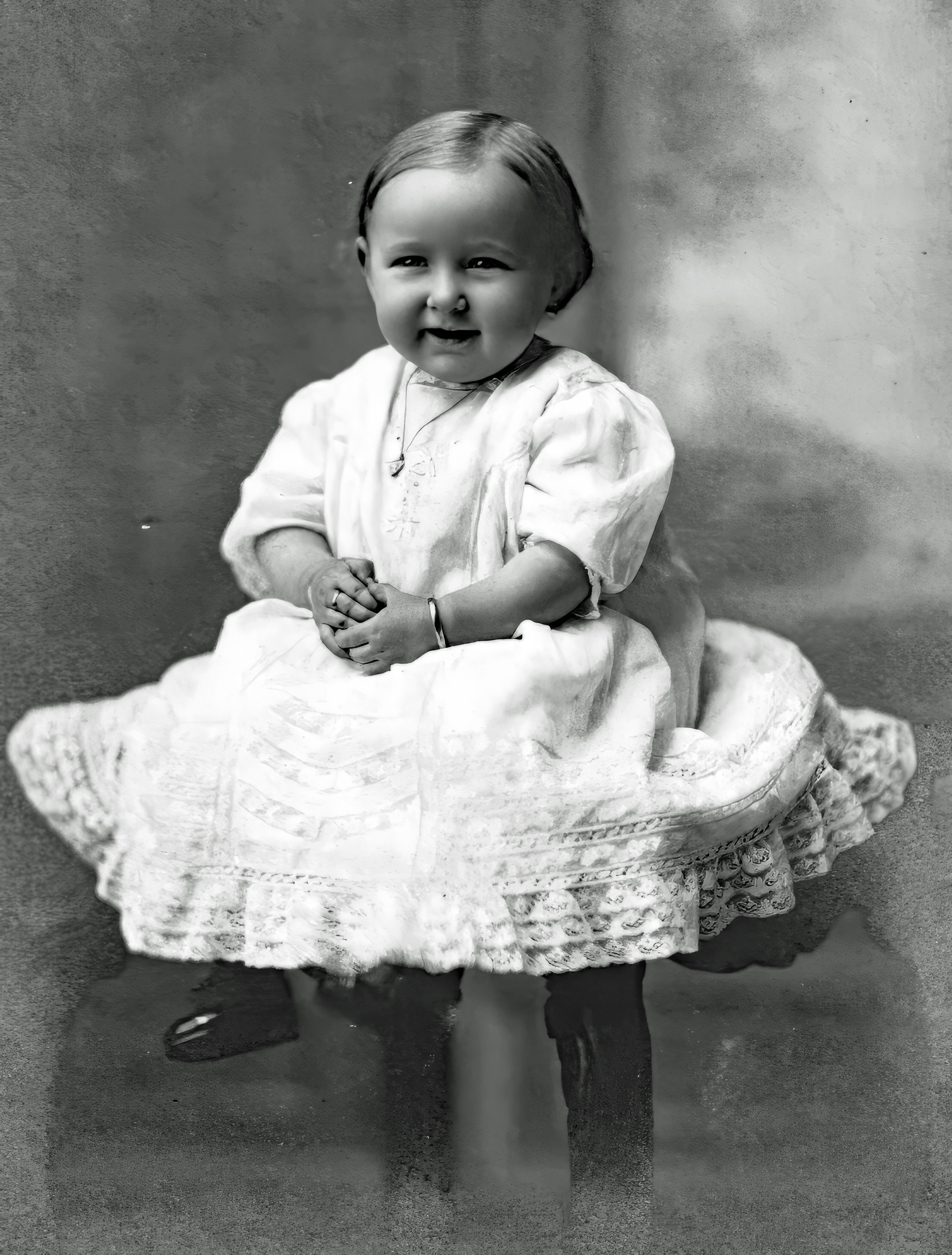
Dorothy Anna Augusta Alex Glawe, c. 1914
Babies are notoriously difficult to photograph, and this was no different a hundred years ago. Some studios had elaborate set-ups where the mother or other family member would secretly hold the infant on her lap while she would be covered by a blanket or fur rug. In Dorothy's case, no such subterfuge was required. Baby Dorothy perches happily on a table for the camera lens and radiates good cheer.
Dorothy was the second daughter of John Walter Glawe and his wife Anna Gohr. Dorothy was born in Chicago in 1913 and by this account appears to have been a happy child. She's decked out in an elaborately embroidered white dress with impeccably coifed hair. Dorothy is unusually bejeweled for a one year old. She wears a necklace, a bangle bracelet, and what looks like a ring on her right hand.
Some photographers employed assistants to distract or amuse the child when posing for portraits. Some had mechanical toys to capture attention. "Watch the birdy!" was not just a figure of speech. Some studios included animated toy birds to elicit a happy response.
Whatever the situation, Dorothy was clearly a winsome subject for the camera. Her family continued to document their three daughters throughout the 1910s and beyond.
Photo collection: Anna Gohr Glawe
![Wedding portrait [?], Walter and Elizabeth Petersen, c. 1912](img/walter-elizabeth-petersen-sharpen.jpg)
Walter and Elizabeth Petersen, c. 1912
This photo has been a mystery for almost twenty years. We don't have a good image of it, just a photocopy of the original studio portrait from Sandberg Studios on 16th Street in Omaha -- which is sad because that studio was renown in its time for producing high-quality silver gelatin prints. But the great mystery remains: who is this couple? It's marked Walter and Elizabeth Petersen, but is that correct?
We have a Walter Petersen, born in Chicago in 1892 to Andrew Petersen and Karen Marie Johannsen Petersen. And we have an Elizabeth Petersen (born Wilhelmina Elizabeth Petersen) to Louis Petersen and Marie Cavalin Petersen in Omaha in 1891. But to our knowledge they were never married to each other.
This portrait may indeed show a married couple but there are anomalies that make it hard to determine this. Walter would have been about twenty years old here and is dressed appropriately for a wedding portrait. Elizabeth however looks quite a bit older than Walter, perhaps in her middle age. She's dressed in dark fabric, which wasn't out of place for weddings in the 19th century but was not the fashion for weddings in the 1910s. Her bouquet is a tightly bundled bouquet of roses wrapped with a gossamer fabric of some sort -- again, not the fashion for bridal bouquets at this time, which were usually a mix of white flowered varieties, particularly traditional blossoms like orange blossoms, stephanotis, and lilies. Bouquets like this one are more often seen in a confirmation or graduation photo, but this lady appears too old for that kind of commemoration.


We know that Walter lived for a time with his uncle Louis Petersen in Omaha. Louis was the twin brother of Andrew Petersen, Walter's father, who had settled in Kenosha. But Louis remained in Nebraska near his brothers (Alfred, Peter, and Hans) who were farmers and laborers in and around Omaha. Louis, on the other hand, ran a saloon on Cuming Street. Walter worked there as a bartender from about 1912-1913, as the directory entry indicated.
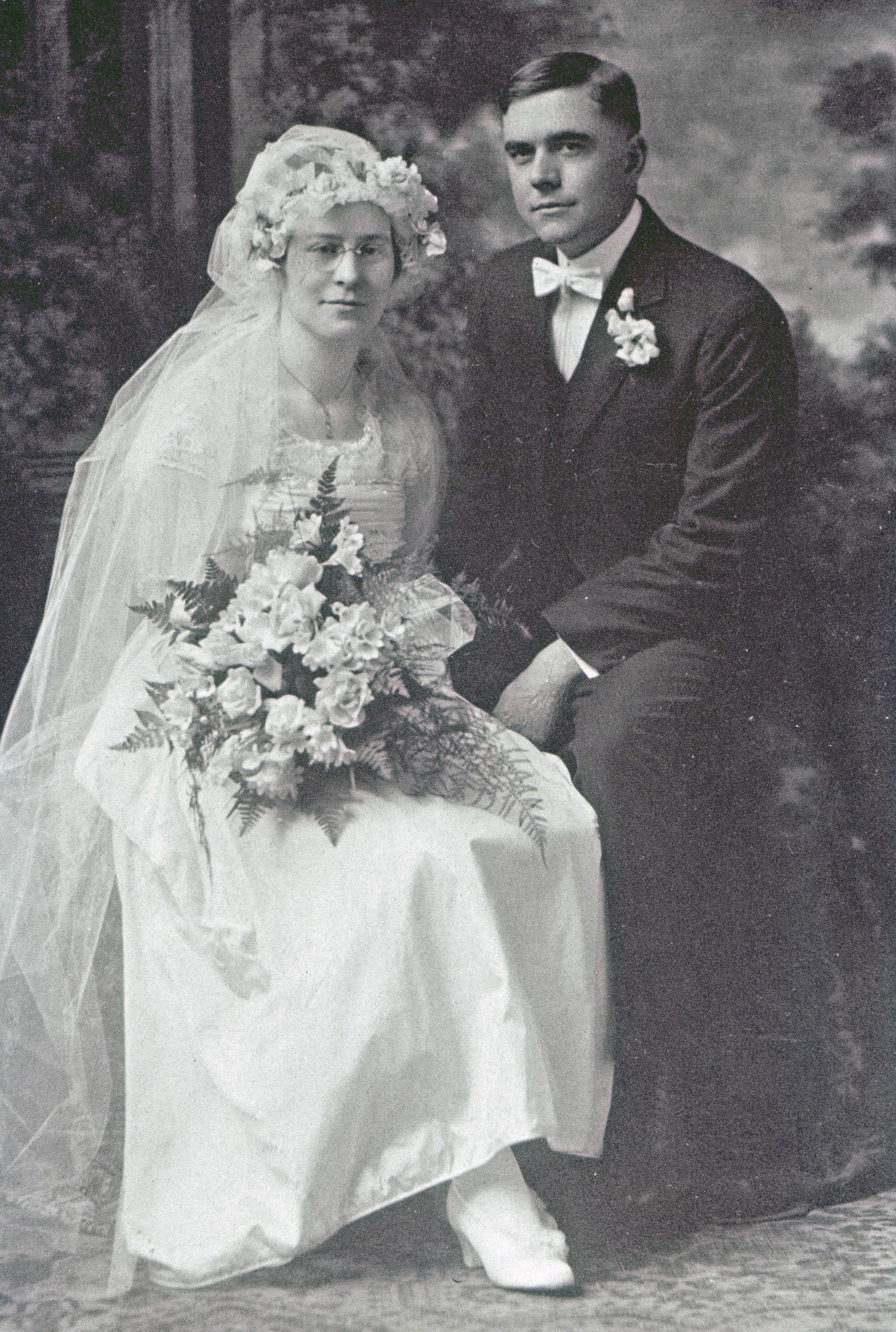
Walter even applied for a passport while he was living in Omaha. Where he was going we have no idea. He may not have used the passport at all. A perusal of Nebraska marriage indexes and Omaha newspaper entries for this period reveals no marriages between our Walter Petersen and anyone named Elizabeth. I think it's safe to assume that this photo does commemorate some kind of event involving Walter, but likely not a marriage. It's even possible that the inscription given to us by our cousin Cathie Meyer is wrong and the photo shows sometone else entirely
By 1917 Walter was back in Kenosha where he married Celestia Bray, born in Independence, Iowa but a long-time resident of Kenosha. It's true that the wedding portrait of Walter and Celestia shows the groom has a strong resemblance to the portrait from about 1912 above. But nothing conclusive can be determined. A mystery it must remain until newer databases become available online to prove or further disprove our investigation.
Photo collection: Cathie Meyer and Michael Petersen
Unknown Petersen family
It's a pretty secure bet that this man and his family are related to the Petersens of Schleswig-Holstein and Omaha, Nebraska. He resembles the five Petersen brothers whom we know and may in fact be one of them. And as was customary for Catharina Petersen, in whose collection this was found, there's considerable damage to the cabinet card from the red cardboard frames that Catharina liked to use for her specially-loved portraits.
The trick is trying to evaluate this family constellation based on who it appears to be and the ages of the individuals. You can click the image to enlarge it.
In the image the woman's dress contains the most details, its elaborate ruffles and folds evocative of fashions in the late 1870s and early 1880s. So too her hairstyle. The tight curled bangs were very popular in the same time period.
Did this family have more children than the ones pictured? It's possible that there were younger children who weren't selected for the portrait for whatever reason. It's also possible that this couple only had two children and they're the ones we see here.
Another question: was this photo staged in Omaha, Nebraska where the photography studio was located, or was it just copied there? A Gray Photography Studio was at 213 N. 16th Street in the 1880s, although this address is a few doors down. The Grand Central Gallery was established on 1 November 1880, so that's the right timeframe, managed by George Heyn, claiming "first class work."
If it was merely copied there, this could be yet another Petersen family, that of Georg Petersen who emigrated from Schleswig to Sandusky, Ohio, although that's rather far afield. Georg and his wife had two children of the right age to be in a photo from about 1880, Nis Heinrich Gustav born in 1869 and Mathilde Petrea Christine, born in 1873. But that family didn't emigrate until the late 1890s and one assumed that if they'd been sharing cabinet cards with family members they would have had them copied in a Sandusky studio. And the children would likely have been grown by that time.
Another option: is this the family of another brother, Hans Petersen, and his wife Christine Johannsen? It could be (they emigrated to Nebraska in 1883) but their children were much younger, born in 1878 and 1880, and unlikely to be in a photo at age eight to ten years with their mother dressed in fashions of the early 1880s.
What we do know: this family includes Petersen relatives, probably the son of Peter Hansen Petersen and Elise Momsen, or Peter's younger brother Georg. And whoever they were, they liked dogs! Sharp eyes will detect a shy black-and-white puppy under the wicker settee.
Photo collection: Cathie Meyer
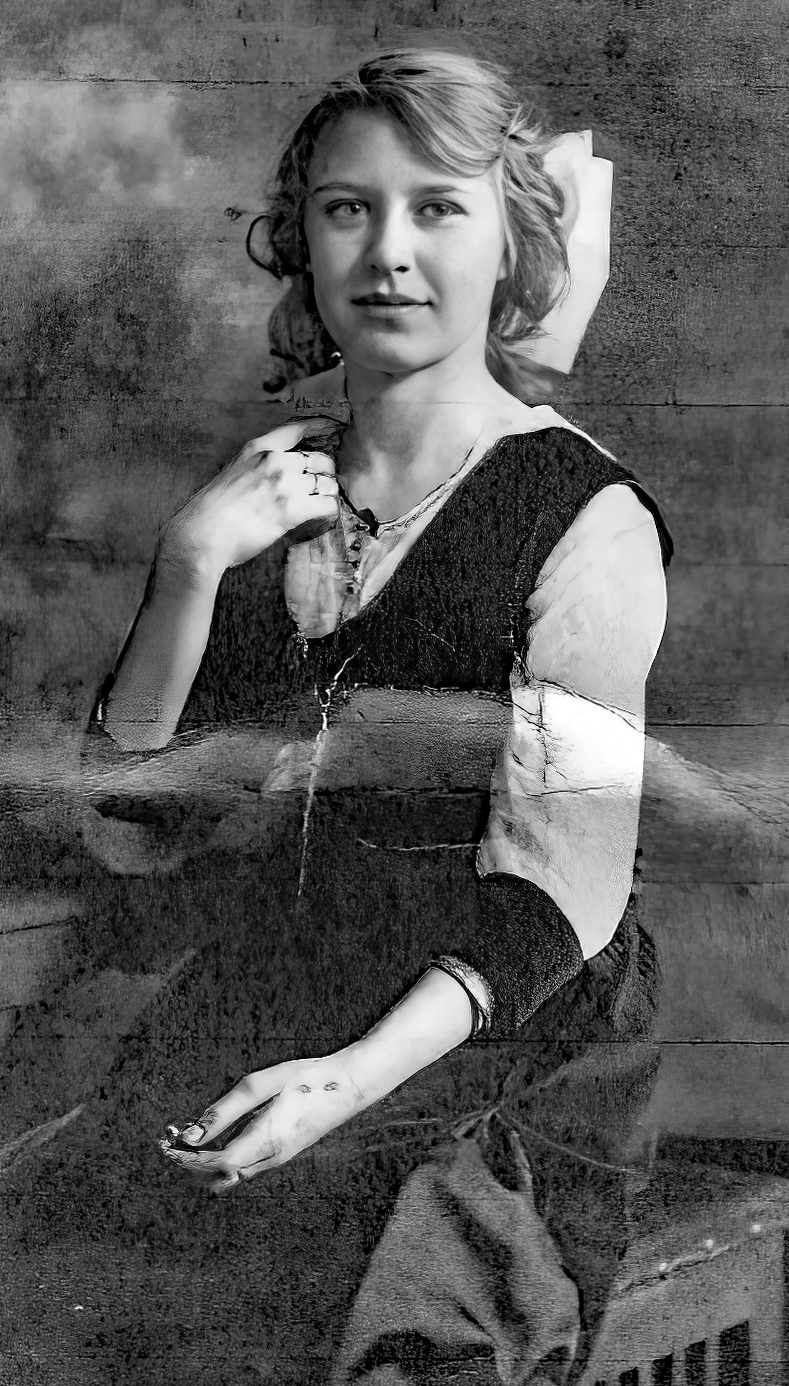
Catherine Clyde Speights
Until recently this captivating photo was unidentified. Sent in by a cousin with several other related but similarly damaged photos, this appears to be a commemorative picture of a communion or high school graduation. Knowing the contributor's connection to the Speights family of Decatur, Georgia, and comparing this photo to several others from yearbooks around the early 1920s at schools she was known to have attended, it seems likely that this is Catherine Clyde Speights (1904-1997), oldest child of Russell Blake Speights and Helen Jennie Marie Müller.
Catherine's ancestry included Evander McIver Speights of Williamsburg, South Carolina. Her father William Blake Speights was born there but relocated to Decatur, Georgia, where Catherine and her siblings were born.
Catherine's mother was Helen Marie Jennie Müller, a granddaughter of Rev. Ludwig Müller of the St. Matthews German Lutheran Church, where to this day Müller descendants are treated like long-lost royalty. Helen's godparents included Helena Müller Melchers, the infant's paternal aunt, Marie Bosch, and Jennie Schwetzer.
Catherine attended attended Agnes Scott College, taught school for several years, and married pharmacist Powell Vaugh Craig in 1932. This newspaper announcement from The Knoxville Journal from 29 May 1932, Sunday Page 12 is effusive in its admiration for the couple. They had twin daughters, Jean and Jo Ann. Powell died in 1966, Catherine in 1997. Both are buried in Bethesda Cemetery in Morristown, Tennessee.
Photo collection: Anne Wheeler
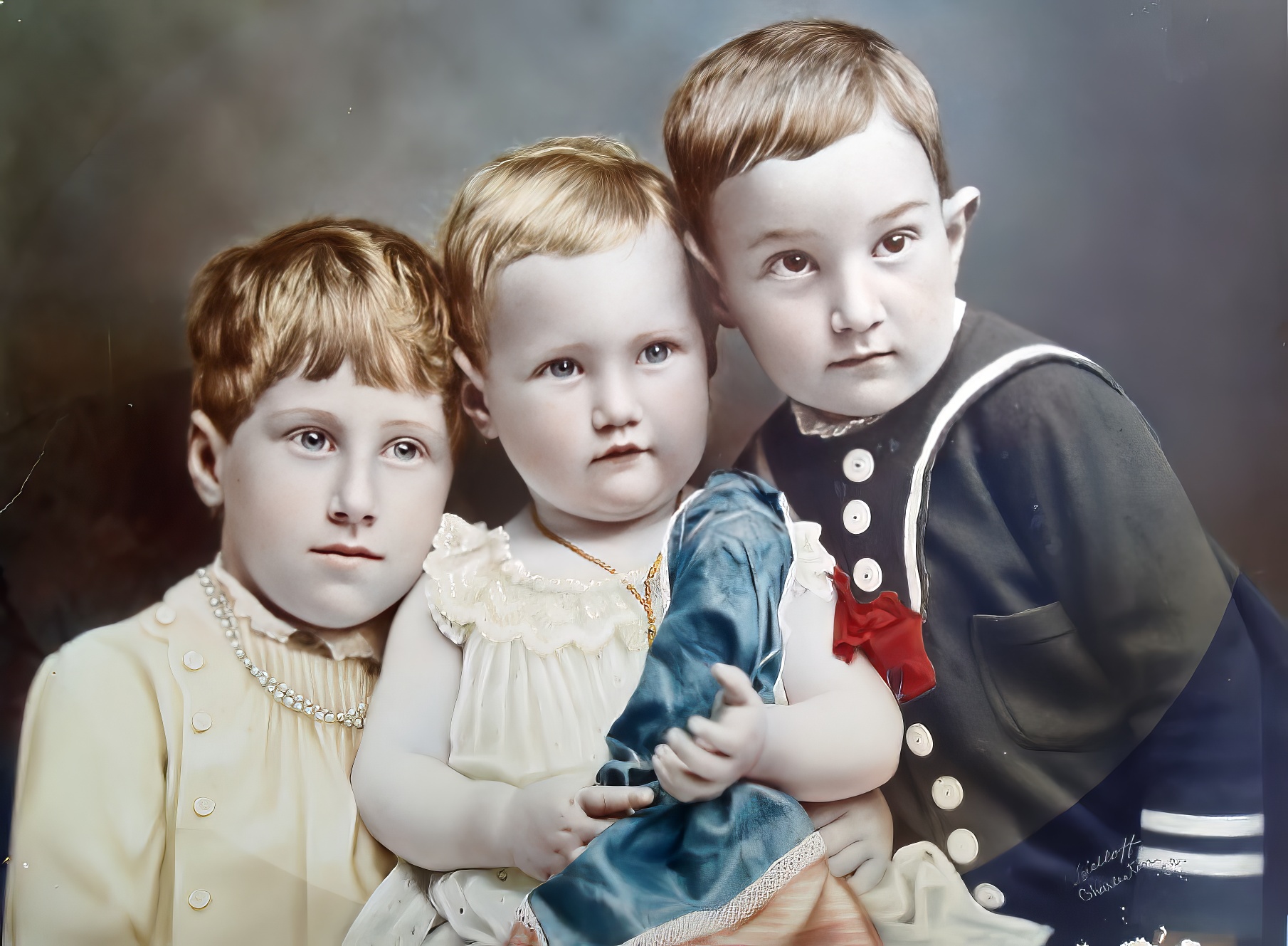
Jatho children, Charleston
We know the date of this hand-tinted photograph because we know the death date of the young man on the right, Herbert Ferdinand William Jatho. Herbert was not quite five years old when he died of "membranous croup" in the town of Walhalla, South Carolina in September 1889.
Walhalla was a town on the western edge of South Carolina where a number of German settlers from Charleston set up a welcoming community for families and friends. Both Herbert's parents, George Jatho and Arnolda von Oven Jatho, were well-respected members of that community, George as a first-generation son of a watchmaker, Arnolda as an immigrant from Cloppenburg with merchant brothers who emigrated with her. George and Arnolda met when they were shopping at a Charleston farmer's market and Arnolda couldn't remember the English word for "cabbage." George stepped in and provided it, and thus a romance was born.
In the portrait are Herbert's sisters: Georgia, on the left, and Maryliese, in the middle, whoe grew up and became prominent members of the Charleston community. Georgia's life was full of charity work and community activities. Maryliese married a widower, Charleston retail merchant Robert Samuel Tiedemann, in 1942, the year after Georgia died. They lived in Greenville, Florida.
George and Arnolda has several other children who didn't survive long enough to be photographed. Arnolda Pauline was born and died in 1883 and Ruby von Oven died at the age of six months in 1888. They and their brother Herbert are buried at Magnolia Cemetery in Charleston.
This portrait has been lovingly preserved by Maryliese's nephew Louis Quin, and we're grateful to be able to display it here.
Photo collection: Louis Quin
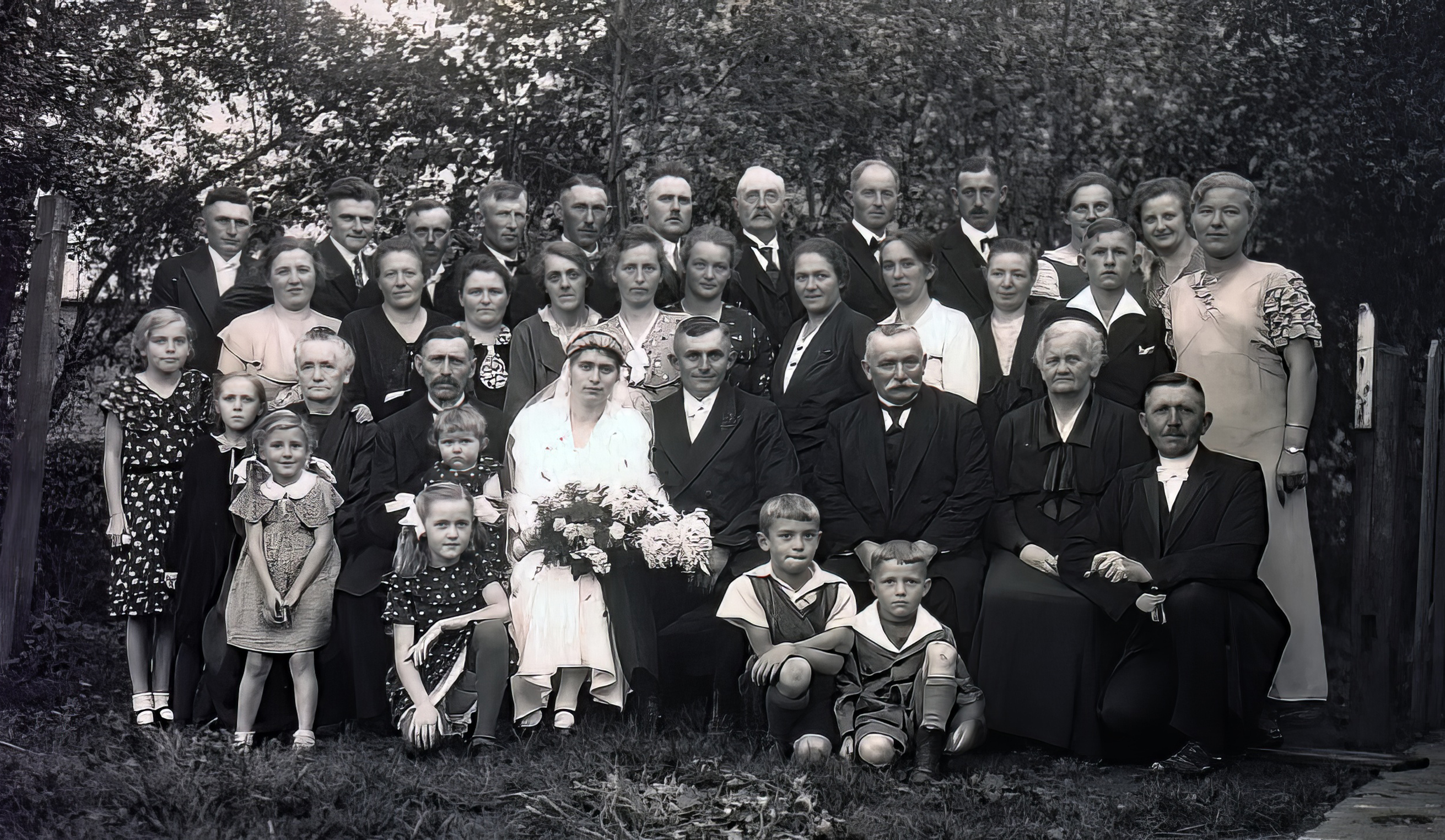
Politz-Petersen marriage, Dithmarschen 1934
Weddings were a big family affair with our Petersens in the twentieth century, especially in Schleswig-Holstein, where Fritz Hinrich Politz and Anna Petersen were married in August 1934. It looks like the whole family was there, including parents of the happy couple as well as cousins galore.
Anna Petersen was one of the daughters of Matthias Peter Petersen and his wife Esther Möller Petersen, born in 1911. She was a granddaughter of Helena Marie Petersen. Her bridegroom was Fritz Hinrich Politz, son of Ferdinand and Marie Politz. It was customary to arrange formal portraits like this with the parents of the bridegroom and bride on either side of the couple, and that's the case here. Esther and Matthias are on the left, surrounded by grandchildren, and Fritz' parents are on the right next to him.
The bride wears a beautiful gown of lace and silk with what looks like a "kokoshnik" style headband holding her veil in place. Her flowers are voluminous, with what appear to be white chrysanthemums and carnations in the bouquet. The groom, in his new suit with a blazing white tie, manages a tentative smile. Although the wedding took place in early October that year the day must have been a fine one. Imagine trying to assemble a crowd like this on a rainy afternoon!
Thanks very much to our cousin Mario Petersen for this wonderful image. We like it so much we're using a colorized version in the banner at the top of this page.
Photo collection: Mario Petersen
Unknown lady, Chicago
You're about to encounter the first in a series of photos from the collection of Catherine Petersen Mikkelsen of Chicago with a most annoying artifact. Catherine apparently liked to use cardboard frames for her most treasured photos that had red pigment in them, which after some years imparted its color into the print itself. She probably didn't know that this would happen, but her collection has a number of photos so marked. We're happy to have them, nevertheless. If you'd like to enlarge the photo, click on it for the full sized image.
Another quirk of Catherine's, which you'll know about if you read the blog, was her propensity for not identifying her photo collection -- not a surprising thing for a person who probably knew who everyone was and figured that she would never forget. But Catherine died in 1944 and a number of her photos remain a mystery to those of us trying to figure them out.
This is one, an elegant lady from about 1894, based on the style of her dress (the bouffant sleeves are a giveaway), probably a widow if the black fabric is any indication. The embroidered detail is notable, as is the pin she wears at her collar, with three diamonds on a branching gold setting oriented downward. Her earrings evade detail but they sparkle with similar stones. Her hair in this tinted image is slightly blonde, her eyes are hazel, possibly accurate, we have no way of knowing.
This is a cabinet card, copied or created at Schneider Studios at 2222 State Street in Chicago. Peter Schneider was in business at this location from 1894 to 1900 and was also associated with Steffins & Schneider as early as 1881 on Archer Avenue. Catherine and her then-husband Hans Petersen came to Chicago from Nebraska about 1891. Hans worked as a laborer while Catherine kept house and raised their children. But photographs were important to Catherine, as her collection suggests.
This lady may have been a relative or a friend. It's likely that she also lived in Chicago. The crispness of the image and the delicate tint suggest that this was an original photo taken at the local studio. Hans and Catherine lived at 4735 South Paulina Street around this time just west of Ashland, while the Schneider Studio was located closer to downtown Chicago, so Catherine had to travel a bit to have this photographic portrait made. In Catherine's collection there are a few women captured in later snapshots who look vaguely like this lady and who wear their hair in a similar style, piled on top of the head, but those photos are also unidentified, so we're back where we started.
Perhaps someday we'll run into someone who has some clues about this enigmatic portrait.
Photo collection: Cathie Meyer
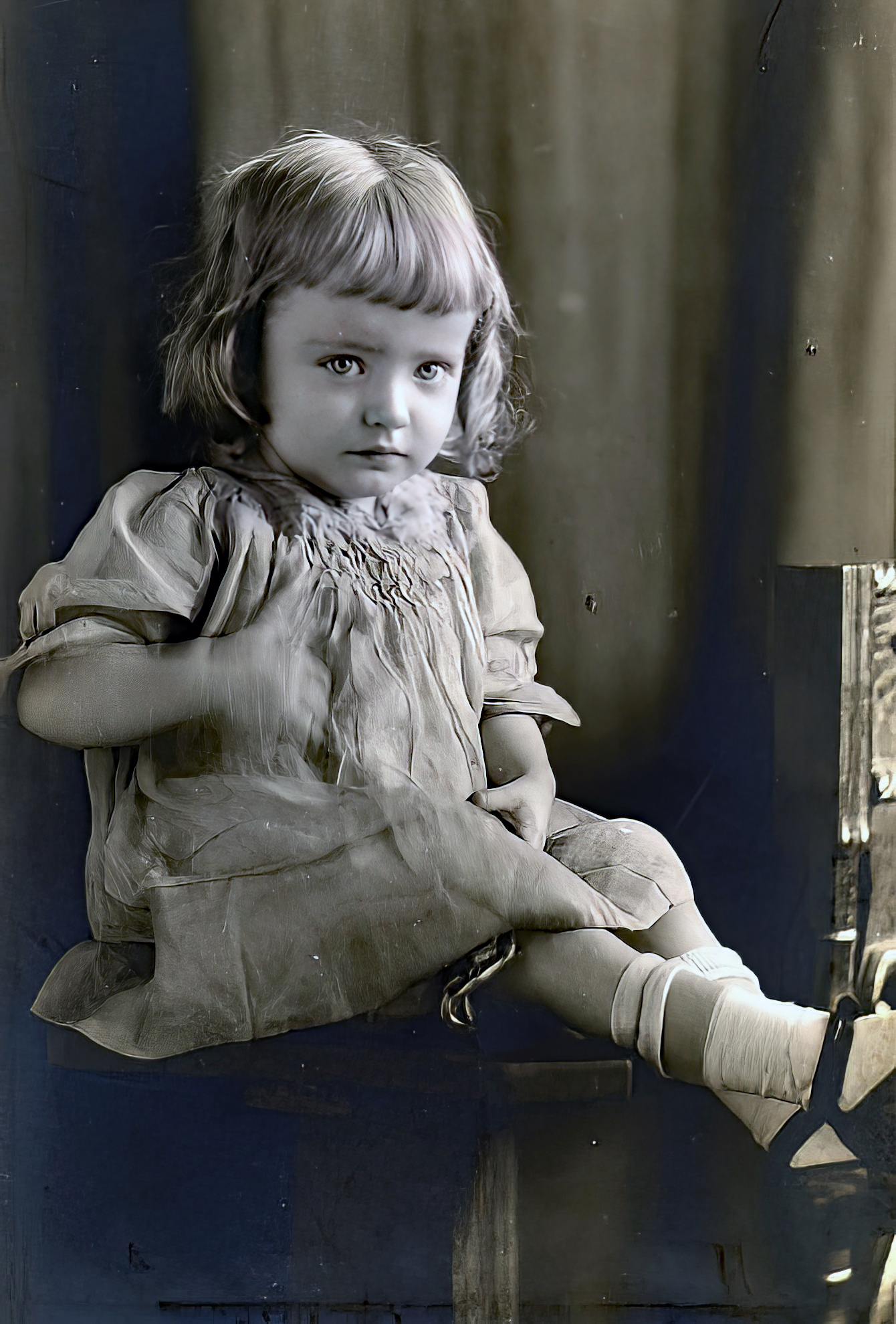
Louise Schmidt, Chicago 1923
It's hard to stay still when you're three years old. Louise Catherine Schmidt tried her best but her right hand fluttered when the photographer snapped his shutter. Maybe she was unaccustomed to the crinoline dress, or perhaps she'd sat still for too long. It's a charming portrait, nevertheless, and her gaze is penetrating.
Louise was the daughter of George H. Schmidt and Marie Petersen, both from Chicago. We know very little about George, who's pictured with Marie and Louise in several snapshots from the early 1920s. We don't know his parents' names. We know Marie -- she was the penultimate child of Hans and Catherine Petersen.
George's and Marie's marriage didn't last long. The family claimed that George suffered from post-traumatic stress from World War I, back then called "shell shock." Whatever the reason, the couple split within a few years of their marriage. We don't know whether he kept in touch with Marie and Louise. Evidence suggests that he was not part of the family circle after the mid-1920s.
Marie reverted to using her original surname, Petersen, and Louise was reared in the company of her mother, grandmother Catherine Petersen, and a host of Petersen and Mikkelsen cousins. She was pictured frequently with her mother Marie. Louise was married twice, once to William Valentine Villanova, with whom she had a daughter Louise, and then to Floyd Zettel, with children Lorelei and Linda. Louise died in 2004 in Wolcottville, Indiana at the age of 83.
Photo collection: Cathie Meyer
